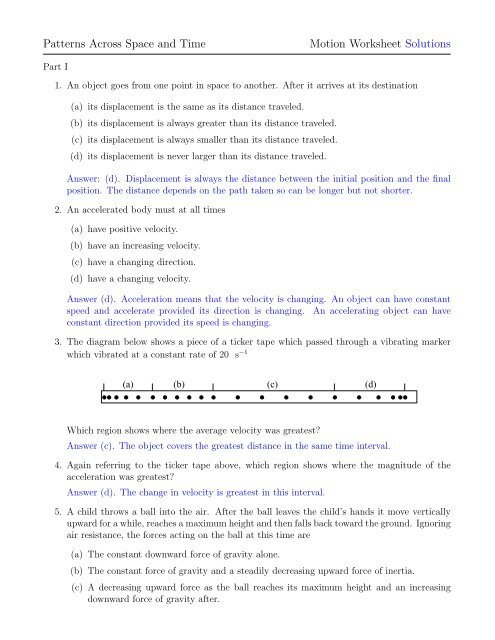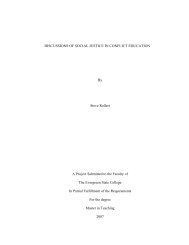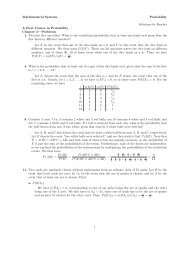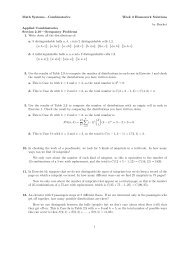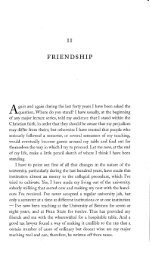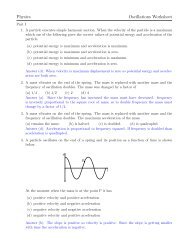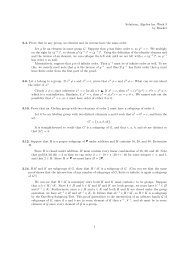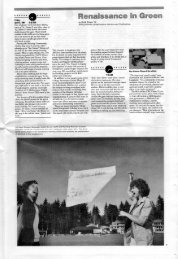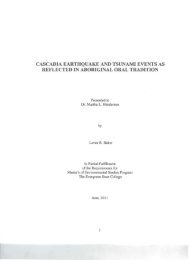Patterns Across Space and Time Motion Worksheet ... - Archives
Patterns Across Space and Time Motion Worksheet ... - Archives
Patterns Across Space and Time Motion Worksheet ... - Archives
Create successful ePaper yourself
Turn your PDF publications into a flip-book with our unique Google optimized e-Paper software.
<strong>Patterns</strong> <strong>Across</strong> <strong>Space</strong> <strong>and</strong> <strong>Time</strong> <strong>Motion</strong> <strong>Worksheet</strong> Solutions<br />
Part I<br />
1. An object goes from one point in space to another. After it arrives at its destination<br />
(a) its displacement is the same as its distance traveled.<br />
(b) its displacement is always greater than its distance traveled.<br />
(c) its displacement is always smaller than its distance traveled.<br />
(d) its displacement is never larger than its distance traveled.<br />
Answer: (d). Displacement is always the distance between the initial position <strong>and</strong> the final<br />
position. The distance depends on the path taken so can be longer but not shorter.<br />
2. An accelerated body must at all times<br />
(a) have positive velocity.<br />
(b) have an increasing velocity.<br />
(c) have a changing direction.<br />
(d) have a changing velocity.<br />
Answer (d). Acceleration means that the velocity is changing. An object can have constant<br />
speed <strong>and</strong> accelerate provided its direction is changing. An accelerating object can have<br />
constant direction provided its speed is changing.<br />
3. The diagram below shows a piece of a ticker tape which passed through a vibrating marker<br />
which vibrated at a constant rate of 20 s −1<br />
(a) (b) (c) (d)<br />
Which region shows where the average velocity was greatest?<br />
Answer (c). The object covers the greatest distance in the same time interval.<br />
4. Again referring to the ticker tape above, which region shows where the magnitude of the<br />
acceleration was greatest?<br />
Answer (d). The change in velocity is greatest in this interval.<br />
5. A child throws a ball into the air. After the ball leaves the child’s h<strong>and</strong>s it move vertically<br />
upward for a while, reaches a maximum height <strong>and</strong> then falls back toward the ground. Ignoring<br />
air resistance, the forces acting on the ball at this time are<br />
(a) The constant downward force of gravity alone.<br />
(b) The constant force of gravity <strong>and</strong> a steadily decreasing upward force of inertia.<br />
(c) A decreasing upward force as the ball reaches its maximum height <strong>and</strong> an increasing<br />
downward force of gravity after.
(d) No forces act on the ball. It returns to the ground naturally.<br />
Answer (a). Gravity is the only force acting on the ball<br />
6. Imagine that you push a car gently but constantly forward with your index finger. Imagine<br />
that the car’s wheels are completely frictionless. How will the car respond to your push?<br />
(a) It will not move unless the push is strong enough to overcome its inertia.<br />
(b) It will move with steadily increasing speed.<br />
(c) It will move at a very small constant speed.<br />
(d) Its speed increase until it reaches a certain value.<br />
Answer (b). Provide you push with a constant force that is not balanced by friction then the<br />
car will continue to accelerate.<br />
7. Imagine that we set a penny near the edge<br />
of horizontal turntable. Then imagine that<br />
we spin the turntable faster <strong>and</strong> faster until<br />
the penny flies off. What path does the<br />
penny follow after if it leaves the turntable<br />
in the indicated position?<br />
Answer (b). After the coin leaves the turntable there is no longer a force keeping it moving in<br />
a circle so it continues in a straight line in the direction it was moving when it left the table<br />
8. A ball is thrown straight up from height H while a second is thrown straight down. Neglect<br />
air resistance. After the balls have been released<br />
(a) the one thrown up has the greater acceleration.<br />
(b) the one thrown down has the greater acceleration.<br />
(c) the accelerations are the same.<br />
(d) neither ball accelerates after it has been released.<br />
Answer (c). After the balls have been released the only force acting on the ball is gravity, so<br />
the acceleration is the same 9.8 m/s 2 acting down.<br />
9. A rock which is dropped from rest reaches a speed of about 10 m/s in 1 second. How far<br />
would you expect it to fall in one second?<br />
(a) about 10 m<br />
(b) more than 10 m<br />
(c) less than 10 m<br />
(d) any of the above.<br />
Answer (c).Its average speed during the first second is 5 m/s so it will travel 5 metres<br />
(a)<br />
(b)<br />
(c)<br />
(d)
Part II<br />
1. An ant walks clockwise around this sheet of paper starting from the top left h<strong>and</strong> corner<br />
traveling at 0.03 m/s.<br />
(a) How far will the ant have walked after 20 seconds?<br />
d = vt = 0.03 × 20 = 0.6 m = 60 cm<br />
(b) Find the position of the ant after 20 seconds <strong>and</strong> hence find its average velocity to get<br />
to that position?<br />
Letter Size Paper is 8.5 in × 11 in which<br />
is 21.6 cm × 27.9 cm.<br />
Since the ant travels a distance 60 cm<br />
around the paper it arrives point P on<br />
the diagram on the right.<br />
By Pythagorus’ Theorem the<br />
displacement <br />
OP is<br />
(27.92 + (21.6 − 10.5) 2 = 30.0 cm<br />
O<br />
21.6 cm<br />
P<br />
10.5 cm<br />
27.9 cm<br />
2. A ball is dropped from above the ground <strong>and</strong> bounces several times before coming to rest.<br />
Assuming the ground is the origin <strong>and</strong> the positive direction is measure upwards sketch graphs<br />
of<br />
(a) position vs. time<br />
(b) velocity vs. time<br />
x<br />
t
(c) acceleration vs. time<br />
v<br />
v<br />
t<br />
t
3. A car travels 120 km along a road at 40 km/hr <strong>and</strong> then immediately returns along the same<br />
road at a speed of 60 km/hr.<br />
(a) How long does each leg of the trip take?<br />
v = d/t so t = d/v. Thus t = 120/40 = 3 hours for the outward trip <strong>and</strong> t = 120/60 = 2<br />
hours for the return trip.<br />
(b) What is the average speed for the round trip? The average speed is total distance over<br />
total time which is 240/5=48 km/hr. Notice the average speed is not 50 km/hr since the<br />
car spends more time going at the slower speed of 40 km/hr.<br />
(c) What is the average velocity for the round trip? Since the car returns to the starting<br />
point the average velocity is zero.<br />
4. In each of the following cases state whether the motion is accelerated or not.<br />
(a) A meteoroid traveling in outer space with negligible gravitational influence.<br />
No acceleration<br />
(b) A satellite orbiting earth at a constant speed of 30,000 km/hr<br />
Acceleration. The speed is constant but the direction changes.<br />
(c) An ice skater coasting on ice in a straight line.<br />
No acceleration assuming friction is negligible<br />
(d) A skydiver falling at terminal velocity?<br />
No acceleration - the skydiver is no longer gaining speed<br />
5. A car is moving at a constant speed of 30 km/hr. The driver then presses harder on the<br />
accelerator causing an acceleration of 2.25 km/hr/sec, which she maintains for 4 seconds.<br />
How fast is the car moving at the end of 4 seconds?<br />
in 4 seconds the car gains 4×2.25 = 9 km/hr so the car is moving at 39 km/hr after 4 seconds.


